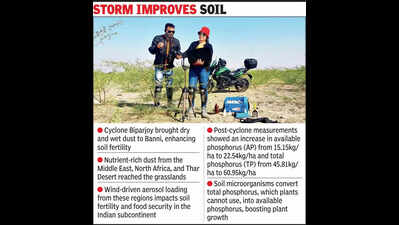- News
- City News
- rajkot News
- Cyclone Biparjoy improved soil fertility in Banni, study finds
Trending
Cyclone Biparjoy improved soil fertility in Banni, study finds
Rajkot: A paper published in a scientific journal by Kutch University researchers has found that cyclones, such as the recent Cyclone Biparjoy, transport essential nutrients such as phosphorus to the Banni grassland in Kutch, affecting soil fertility.
The study examined the effects of Biparjoy's winds from the Middle Eastern deserts and their impact on phosphorus levels at Banni, Asia's largest tropical grassland, which showed a notable increase after the cyclone. This research underscores how winds during a cyclone distribute nutrients, particularly in arid and semi-arid regions with limited phosphorus.
The research was carried out by experts from various institutions: Seema Sharma and Rupak Dey (Kutch University), Mahesh Thakkar (Birbal Sahni Institute of Palaeosciences), Ranjit Kumar Sarangi (Isro) and Abhiroop Chowdhury and AliyaNaz (OP Jindal Global University).
Their analysis covered 40 years of data, including NASA's MERRA-2 satellite data, to understand phosphorus distribution patterns.
"As winds carry dust from the MENA and Thar Desert regions, they bring with them phosphorus rich particles that settle on soils, beginning in western Gujarat and extending across areas such as the Banni grasslands, reaching all the way to the Himalayan ranges and other ecosystems throughout the Indian subcontinent. This dust acts as a natural fertilizer, supporting the growth of vegetation and agricultural crops critical to India's food supply. The dust transports essential phosphorus which enriches the soil, promoting plant growth and health," said Dey
The research team used NASA's MERRA-2 satellite data to examine phosphorus patterns over four decades, from 1981 onwards. They studied wind patterns' influence on dust and nutrient transport. Under normal conditions, phosphorus deposits as dry dust, but during cyclones or rain, it becomes wet deposition, making it more accessible to plants.
Cyclone Biparjoy caused both dry and wet dust deposition in Banni, enhancing the arid land's fertility. This nutrient-rich dust also reaches North India, accumulating in the Himalayan region.
"Analysis of the data showed how winds from the Middle East and North Africa (MENA) and the Thar Desert region contribute significantly to aerosol loading in the Banni grasslands and across India. This tells us how this wind affects the food security of the subcontinent," Sharma added.
The researchers identified two soil phosphorus forms: total phosphorus (TP), unavailable to plants, and available phosphorus (AP), which plants can use. Soil microorganisms convert TP into AP.
Pre-Biparjoy measurements showed AP at 15.15kg per hectare and TP at 45.81kg per hectare. Post-cyclone values rose to 22.54kg per hectare for AP and 60.95kg per hectare for TP. The highest TP concentration reached 61.89kg per hectare 20 days after the cyclone.

About the Author
Nimesh KhakhariyaEnd of Article
FOLLOW US ON SOCIAL MEDIA







